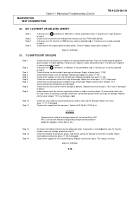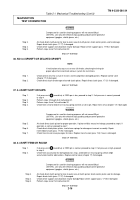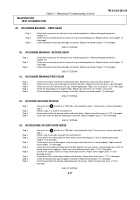TM-9-2320-280-34 - Page 50 of 1258
TM 9-2320-280-34
Table 2-3. Air Conditioning Troubleshooting (Cont ’d)
MALFUNCTION
TEST OR INSPECTION
f.
Check for High Side Restriction
Step 1.
Perform malfunction 1a, steps 1 through 4.
Step 2.
Check low side of manifold gauge for low reading and high side for normal to high reading (table 2-2). If
discharge (evaporator) air is cool and high side refrigerant lines are cold, wet, or frosted, remove liquid line
(para. 14-17), flush line (para. 14-17), and replace dryer bottle (para. 14-19).
NOTE
If blockage then occurs in liquid lines, condenser, receiver-drier, or expansion
valve, frost may build up just beyond point of restriction.
g.
Check Condenser
Step 1.
Perform malfunction 1a, steps 1 through 4.
Step 2.
Check low side of manifold gauge for normal or high reading and high side for high reading (tabl
e 2-2). If
discharge (evaporator) air is warm, liquid line is hot, air flow through condenser is restricted, bubbles are
seen in sight glass, then clean condenser exterior, if dirty. If condenser fans are inoperative, refer to
electrical system troubleshooting (TM 9-2320-280-20) Flush condenser (para. 14-17) or replace condenser
(para. 14-24), if damaged.
h.
Check for Overcharged System
Step 1.
Perform malfunction 1a, steps 1 through 4.
Step 2.
Check low side of manifold gauge for normal to high readin
g and high side for high reading (table 2-2). If
system runs continuously, compressor is noisy on start-up, discharge (evaporator) air is warm, a partial
system discharge is required, continue to step 3.
Step 3.
Insert center hose of manifold gauge set in a catch bottle or can.
NOTE
Do not allow refrigerant, R-12, to escape too quickly. Refrigerant oil will escape.
Step 4.
Turn low pressure gauge valve and high pressure gauge valve counterclockwise slightly to permit
refrigerant to slowly escape through
center hose until correct pressure and high side pressure are obtained.
END OF TESTING!
2.
INTERMITTENT COOLING
Check air-conditioner output for temperature variation. If air is intermittently warm and cold, perform the following:
Step 1.
Check for air or moisture in system by performing malfunction lb.
Step 2.
Ensure temperature sensing probe is inserted properly in the evaporator fins near the outlet
(para. 14-14).
Step 3.
Perform mechanical troubleshooting malfunction 9.
Step 4.
Check sight glass reading for oil streaks, indicating too much oil in system.
Step 5.
If oil is found in system, flush system (para. 14-17), replace dryer bottle (para. 14-19), and change oil
(para. 14-17).
END OF TESTING!
2-23
Back to Top




















